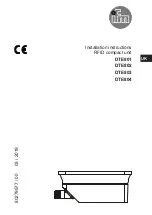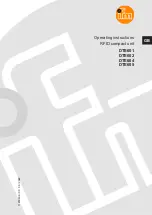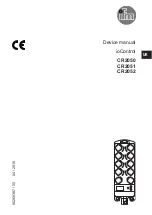
Section 7. Installation
BeginProg
Scan
(1,Sec,10,0)
'<<<<Buffers added
SubScan
(5,mSec,190)
'<<<<Interval, Units, and Count determine speed and number of measurements
VoltSe
(BurstSE(),8,mV2_5,1,False,100,250,1.0,0)
CallTable
BurstSETable
NextSubScan
NextScan
EndProg
Many variations of this basic code can be programmed to achieve other burst rates and duty
cycles.
The
SubScan()
/
NextSubScan
instruction pair introduce additional complexities.
The
SubScan() / NextSubScan Details
(p. 231),
introduces some of these. Caution
dictates that a specific configuration be thoroughly tested before deployment.
Generally, faster rates require measurement of fewer inputs. When testing a
program, monitoring the
SkippedScan
(p. 628),
BuffDepth
(p. 612),
and
MaxBuffDepth
(p. 620)
registers in the CR1000
Status
table may give insight into
the use of buffer resources. Bear in mind that when the number of
Scan()
/
NextScan
buffers is exceeded, a skipped scan, and so a missed-data event, will
occur.
7.9.14.2.1 Measurements from 101 to 600 Hz 2
•
The number of
Counts
(loops) of a sub-scan is limited to 65535
•
Sub-scans exist only within the
Scan()
/
NextScan
structure with the
Scan()
interval set large enough to allow a sub-scan to run to completion of its
counts.
•
Sub-scan interval (i) multiplied by the number of sub-scans (n) equals a
measure time fraction (MT
1
), a part of "measure time", which measure time is
represented in the
MeasureTime
register in table
Status Table Fields and
Descriptions
(p. 603).
The
EndScan
instruction occupies an additional 100 µs
of measur
e time, so the interval of the main scan has to be ≥ 100 µs plus
measure time outside the
SubScan()
/
EndSubScan
construct, plus the time
sub-scans consume.
•
Because the task sequencer controls sub-scans, it is not finished until all sub-
scans and any following tasks are complete. Therefore, processing does not
start until sub-scans are complete and the task sequencer has set the delay for
the start of the next main scan. So, one
Scan()
/
NextScan
buffer
holds all
the raw measurements inside (and outside) the sub-scan; that is, all the
measurements made in a single main scan. For example, one execution of the
following code sequence stores 30000 measurements in one buffer:
Scan
(40,Sec,3,0)
'Scan(interval, units, buffers, count)
SubScan
(2,mSec,10000)
VoltSe
(Measurement(),3,mV5000,1,False,150,250,1.0,0)
CallTable
All4
NextSubScan
NextScan
Note
Measure time in the previous code is 300 µs + 19 ms, so a
Scan()
interval
less than 20 ms will flag a compile error.
•
Sub scans have the advantage of going at a rate faster than 100 Hz. But
measurements that can run at an integral 100 Hz have an advantage as
232
Содержание CR1000
Страница 2: ......
Страница 4: ......
Страница 6: ......
Страница 32: ......
Страница 36: ......
Страница 38: ......
Страница 40: ......
Страница 60: ...Section 4 System Quickstart Figure 16 PC200W View Line Graph 60 ...
Страница 96: ......
Страница 98: ...98 ...
Страница 302: ......
Страница 350: ...Section 8 Operation Figure 91 Pulse Sensor Output Signal Types Figure 92 Switch Closure Pulse Sensor 350 ...
Страница 453: ...Section 8 Operation Figure 115 Using the Keyboard Display 453 ...
Страница 454: ...Section 8 Operation 8 8 1 Data Display Figure 116 Displaying Data with the Keyboard Display 454 ...
Страница 456: ...Section 8 Operation Figure 118 Real Time Custom 456 ...
Страница 457: ...Section 8 Operation 8 8 1 3 Final Memory Tables Figure 119 Final Memory Tables 457 ...
Страница 458: ...Section 8 Operation 8 8 2 Run Stop Program Figure 120 Run Stop Program 458 ...
Страница 460: ...Section 8 Operation Figure 122 File Edit 460 ...
Страница 461: ...Section 8 Operation 8 8 4 PCCard Memory Card Display Figure 123 PCCard CF Card Display 461 ...
Страница 478: ......
Страница 506: ......
Страница 536: ......
Страница 636: ......
Страница 642: ......
Страница 644: ......
Страница 676: ......
Страница 677: ......
















































